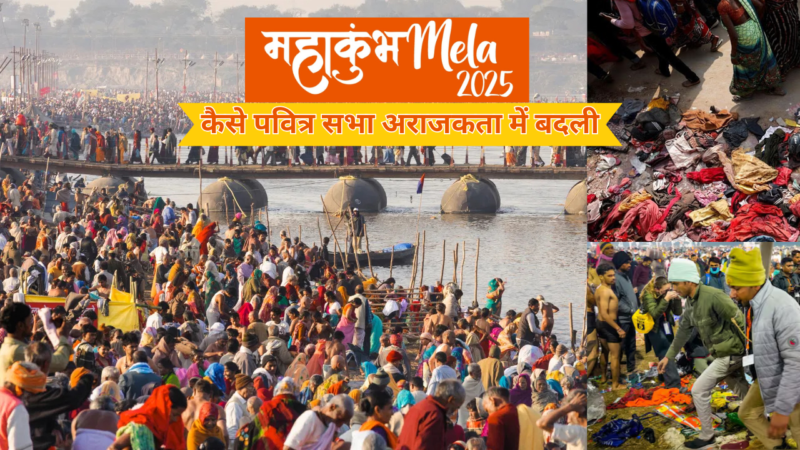The Maha Kumbh, known as one of the world’s largest spiritual gatherings, took a tragic turn this year, leaving many questioning the balance between faith and management. While millions arrived seeking spiritual solace and liberation, inadequate crowd control and insufficient infrastructure led to unexpected chaos. Stampedes, poor communication, and lack of emergency services exposed critical flaws in planning. This unfortunate incident underscores the urgent need for better preparation to ensure the safety and sanctity of such grand events.

In this article, we will explore the significance of the Maha Kumbh, the lessons learned from past incidents, and the steps taken by the administration to ensure a safe and memorable experience for all attendees.
Who Is Responsible for the Tragic Incidents at the Recent Mahakumbh? What Was Lacking?
The tragic incidents at last week’s Mahakumbh have left many questioning the responsibility and preparedness of the event’s management. While the exact cause of the chaos is under investigation, several key factors point to gaps in planning and execution.

- Overcrowding and Poor Crowd Management
One of the primary issues was the lack of adequate measures to control the massive influx of devotees. With millions of people attending, authorities appeared unprepared to manage the crowd, resulting in stampedes and chaos. - Insufficient Emergency Services
The lack of adequate medical teams and first responders escalated the crisis. Everything unfolded so quickly that the situation spiraled out of control. As a result, many victims were deprived of timely assistance, leading to unfortunate and preventable losses of life. - Inadequate Infrastructure
Temporary arrangements like barricades and pathways were either insufficient or poorly maintained, failing to handle the sheer scale of the gathering. - Lack of Clear Communication
The absence of proper communication systems to guide and inform attendees during emergencies further aggravated the crisis, leaving many unaware of safe routes or exits.
What Steps Were Taken by the Mela’s Administration to Control the Crowd in Mahakumbh?
To ensure the safety and smooth functioning of the Maha Kumbh Mela, the administration has implemented several measures for crowd control. Here are the key steps taken:
- Deployment of Security Personnel: A significant number of police and security forces were stationed to manage crowd movement and maintain order.
- Installation of Barricades: Temporary barricades were set up to guide the flow of devotees and prevent overcrowding in key areas.
- Monitoring Through CCTV Cameras: Surveillance systems were installed at major entry and exit points to monitor crowd behavior and identify any potential risks. Use of AI-based tools and real-time monitoring to track crowd density.Deployment of drones and CCTV cameras for aerial surveillance, so that check properly what happen in Kumbh mela.
- Announcements and Signage: Public announcement systems and clear signage were used to guide attendees and provide real-time updates.
- Designated Entry and Exit Points: Specific pathways were designated for entry and exit to avoid congestion and streamline movement.
- Deployment of Volunteers: Volunteers were appointed to assist with crowd control, guide visitors, and respond to emergencies.
- Emergency Response Teams: Medical teams and quick response units were placed on standby to address any health or safety issues.
- Capacity Limits in Certain Areas: Some high-risk areas were temporarily closed off when the crowd exceeded safe limits.
These measures, though well-intended, highlighted areas for improvement in handling such massive gatherings.
What Lessons Did the Administration Learn After the Devotee Incident in Mahakumbh?
The Maha Kumbh Mela is a massive event, and managing such a large crowd is no small feat. Over the years, there have been incidents that highlighted the challenges of crowd control and safety. Here are some key lessons learned:
- Importance of Crowd Management: The administration realized the need for better crowd management strategies to prevent stampedes and ensure smooth movement of devotees.
- Infrastructure Upgrades: Past incidents emphasized the need for robust infrastructure, including temporary bridges, wider pathways, and better sanitation facilities.
- Emergency Response: The importance of having a well-equipped emergency response team, including medical staff and ambulances, was highlighted.
- Communication Systems: Effective communication systems, such as public address systems and mobile alerts, were identified as crucial for disseminating information quickly.
- Collaboration with Local Authorities: The administration learned the importance of collaborating with local authorities, NGOs, and volunteers to ensure a seamless experience for attendees.
Healing the Scars of Mahakumbh and How They Will Be Healed
The Maha Kumbh Mela is a celebration of faith, spirituality, and unity. However, past events have also witnessed incidents that left scars, both physical and emotional. These incidents have served as lessons, prompting the administration and stakeholders to take proactive steps to ensure a safer and more organized experience for future gatherings. Here’s how the wounds of Mahakumbh are being healed and what steps are being taken to prevent similar incidents in the future:
Learning from Past Mistakes
The Mahakumbh, one of the largest religious gatherings in the world, is a testament to India’s rich cultural and spiritual heritage. However, organizing an event of such magnitude comes with immense challenges. As we prepare for Mahakumbh 2025, it is crucial to reflect on past mistakes and implement strategies to ensure a safer, more organized, and seamless experience for all attendees.
Crowd Management for kumbh
One of the most significant challenges during previous Mahakumbhs has been managing the massive crowds. Overcrowding has often led to stampedes, injuries, and even fatalities. To address this, advanced crowd control measures must be implemented. This includes deploying AI-based surveillance systems, real-time crowd monitoring, and creating designated entry and exit points. Additionally, increasing the number of volunteers and trained personnel can help manage the flow of devotees more effectively.
Sanitation and Hygiene
In the past, inadequate sanitation facilities have been a major concern, leading to health hazards and environmental pollution. For Mahakumbh 2025, a robust waste management system must be put in place. This includes setting up more temporary toilets, ensuring regular cleaning, and promoting waste segregation. Awareness campaigns can encourage devotees to maintain cleanliness and dispose of waste responsibly.
Healthcare Facilities
With millions of people gathering in one place, the risk of health emergencies increases significantly. Past events have highlighted the need for better medical infrastructure. For 2025, temporary hospitals, first-aid centers, and ambulances should be strategically located across the venue. Additionally, a team of doctors, paramedics, and emergency response teams must be on standby to handle any situation promptly.
Traffic and Transportation
Traffic congestion and inadequate transportation arrangements have been persistent issues during previous Mahakumbhs. To avoid this, a comprehensive traffic management plan should be developed. This includes creating dedicated lanes for emergency vehicles, improving public transport connectivity, and providing clear signage for parking and drop-off points. Encouraging the use of shuttle services can also reduce vehicular congestion.

Environmental Sustainability
The environmental impact of such a large gathering cannot be ignored. Past events have seen significant damage to the riverbanks and surrounding areas. For Mahakumbh 2025, eco-friendly practices should be prioritized. This includes minimizing plastic usage, promoting the use of biodegradable materials, and organizing clean-up drives post-event. Collaborating with environmental organizations can help ensure sustainable practices are followed.
Communication and Information Dissemination
Effective communication is key to managing an event of this scale. In the past, misinformation and lack of proper communication have caused confusion among attendees. For 2025, a centralized information system should be established. This could include mobile apps, digital signboards, and helpline numbers to provide real-time updates on schedules, safety guidelines, and emergency protocols.
Security Measures
Ensuring the safety of millions of devotees is paramount. Past events have faced challenges related to theft, lost individuals, and security breaches. For Mahakumbh 2025, a multi-layered security approach should be adopted. This includes deploying CCTV cameras, increasing police presence, and using technology like facial recognition to identify potential threats. Lost-and-found centers and help desks can assist devotees in case of emergencies.
Cultural Sensitivity and Inclusivity
The Mahakumbh attracts people from diverse backgrounds, cultures, and traditions. Past events have sometimes faced criticism for not being inclusive enough. For 2025, efforts should be made to ensure that the event is welcoming to all. This includes providing facilities for differently-abled individuals, respecting cultural differences, and promoting harmony among attendees.
Conclusion
The Maha Kumbh Mela is not just an event; it is a symbol of faith, resilience, and unity. While past incidents have left scars, they have also provided valuable lessons that are shaping the future of this grand gathering. By addressing infrastructure gaps, improving crowd management, and leveraging technology, the administration is committed to ensuring a safe and spiritually enriching experience for all attendees.
As we look forward to the Maha Kumbh Mela 2025, the focus remains on healing the wounds of the past and creating a brighter, safer future for this timeless tradition. Together, we can transform the scars into stepping stones for a more organized and harmonious event.

